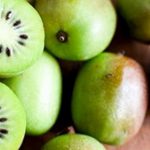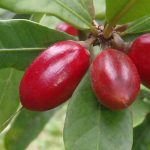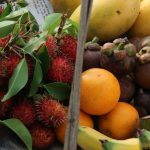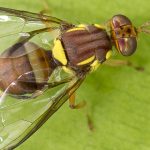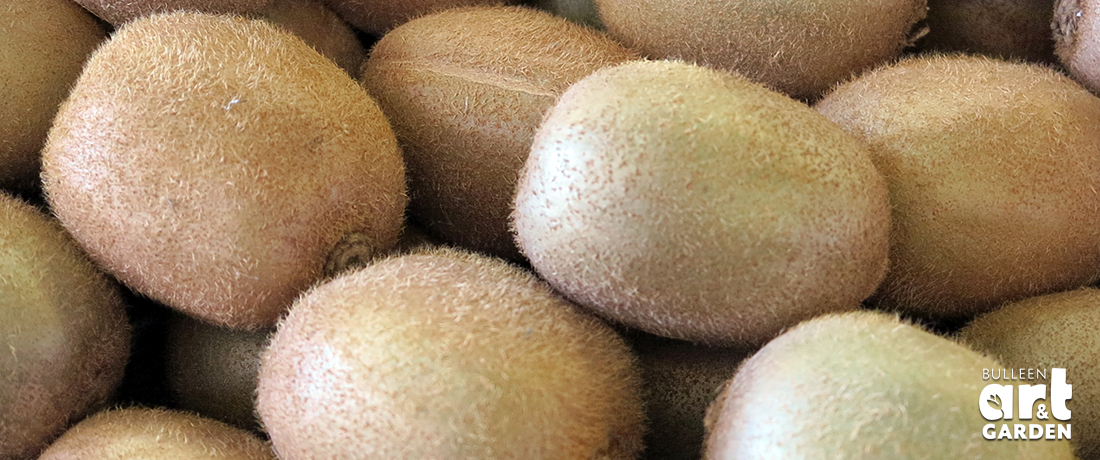
You need a male and a female of these very vigorous vines, so allow for both a sturdy supporting structure and plenty of room. They grow at a very fast pace over spring and early summer and will rapidly cover a large structure with lovely rounded leaves providing perfect summer shade, but also dropping their leaves in winter to allow winter light in. Flowering in late spring, the male flowers will pollinate the female flowers and the fruit develops slowly, being generally ready to harvest over winter.
Intolerant of poor drainage, doing best in good quality deep loamy soil well enriched with manures. Feed well over spring (high Nitrogen fertiliser) when the vines are growing rapidly and water well in summer. Be patient because your kiwi will not fruit for the first few years, fruit will start to appear after 5 years or so and gradually the crop will become heavier until you have a very prolific fruiting vine at age 7 or 8 years. Prune hard in winter. Their vigorous growth habit means they will end up a tangled overcrowded mess unless you remove excess growth. Fruit appears on the first 6 or 7 buds on new wood.
 Important note about plant availability. Important note about plant availability.There are hundreds of factsheets on our website provided for your information. Not all plants will be available at all times throughout the year. To confirm availability please call (03) 8850 3030 and ask for the nursery. |
Kiwi Fruit – Haywood (Female)
Deciduous twining vine, covered with fine hairs, with large, rounded, lime green leaves. Female flowers have central thick white styles. Also known as Chinese Gooseberry. Late season maturity. Suited to strong trellis or pergola, this cultivar isn’t quite as rampant as other cultivars. Large, even-sized broad oval fruit. The greenish-brown skin is covered by short, fine silky hairs. Excellent keeping qualities and good flavour. Used for fresh fruit, jam, wine and food presentation. Very high in vitamin C.
Male Vine
The male vine is more vigorous than the female vine. Plant in a protected site on secure trellis. Winter prune to remove water shoots. Does not produce fruit but necessary for the production of fruit on the female vine.
Kiwi Fruit – Bruno (female)
A very vigorous climbing plant, which is highly productive of delicate tasty fruit that ripen in May (earlier than Haywood). Needs frequent pruning to keep in check but capable of bearing very heavy crops. Large and elongated, with a dark brown skin, with dense, short, bristly hairs. Light green flesh of good flavour. With a relatively low chilling requirement.
Kiwi Fruit – Dexter (female)
A low chill cultivar which bears early in life and keeps longer than Bruno. Needs fruit thinning and severe pruning.
Pruning and Training your Kiwi Fruit
Kiwi fruit are vigorous deciduous vines that must be pruned and trained to manage them. They are usually pruned in winter when they are dormant, but also require pruning several times during summer after flowering.
These vines are trained in a T-shape with a trunk and two side branches (also called laterals or cordons) that are trained over a pergola or trellis.
Training begins in the first year to establish this shape, and the vines usually begin fruiting by their fourth or fifth year. Kiwifruit vines reach peak production after the eighth year and can live for more than 50 years.
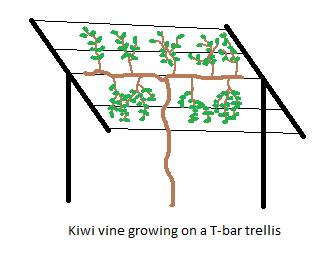
Steps in Training a Kiwi Vine
First Season – develop a straight trunk that reaches the top of the support.
Second Season – establish main permanent side branches (cordons) and tie down to support structure.
Third Season – prune to create a framework with fruiting canes growing every 20-30cm from the main permanent side branches (cordons).
Fourth Season – the framework of fruiting canes is now established. These fruiting canes may be renewed each year, or pruned so they are retained for 2-3 years and then renewed.
Pruning an Established Kiwi Vine
Kiwifruit produce fruit on current season’s growth that is growing from buds on one year old wood (previous season canes). Shoots growing from older wood are rarely productive.
These vigorous vines are pruned heavily just like grape vines. Up to 70% of the previous season’s growth is removed to renew the fruiting wood.
Female plants produce fruit but male plants only produce flowers for pollination, so each is pruned differently.
Kiwi fruit are pruned both in winter and summer to manage their growth.
Winter Pruning Kiwifruit
The best time to winter prune a kiwi vine is early to mid winter, as later pruning may cause excessive sap flow from the pruning cuts, which can weaken the vine.
Winter pruning female kiwi vines
A female kiwifruit vine is pruned to create a framework which has fruiting cane growing every 20-30cm on either side of the permanent side branches (laterals or cordons). Therefore each metre length of lateral branch will carry 6-10 fruiting canes.
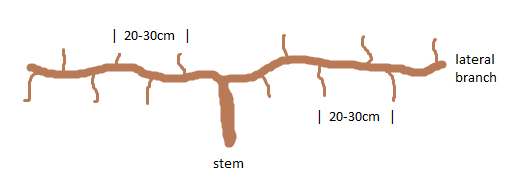
New fruiting canes usually grow from the base of last year’s canes.
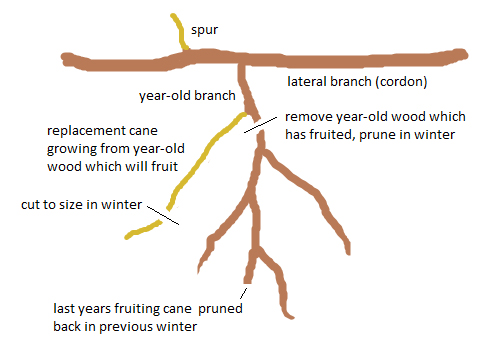
- Remove older canes that have already fruited, leaving new fruiting canes growing from the base of last year’s canes, spaced every 20-30cm along the permanent main branch.
- Shorten these new replacement fruiting canes to a manageable length to force growth of fruiting side branches next season, and tie them to the support wires. Do not twist canes around support wires as this restricts sap flow and the canes may strangle themselves.
- Remove any canes that are diseased, broken, tangled, crossing or rubbing on other canes.
Any new fruiting canes growing directly from the cordon may be left to replace older wood in the future. Any spurs (short fruiting branches with buds close together) which usually grow from the older wood, such as the main cordon itself, should be left as they are very productive.
Winter pruning male kiwi vines
The only purpose of male kiwi fruit vines is to produce flowers for pollination, and since they grow more vigorously than the females, their pruning requirements are slightly different.
- The winter pruning of male vines is actually carried out much later in spring, straight after flowering.
- After flowering prune back the canes to 15-30cm long. The new growth produced in summer will produce flowers in the following year.
Summer Pruning Kiwifruit
In summer kiwi fruit will grow very vigorously, and most of this new growth should be removed.
- If the kiwi vine has fruited, cut back the canes to 3-4 buds (leaves) after the fruit so the vine puts its energy into developing the fruit rather than more green growth.
- Prune back all vigorous upright growth (water shoots) back to two buds.
- If fruit is shaded it will not ripen, so prune away all other green growth except for any shoots growing from the base of the fruiting cane. Shorten these to two to three buds to provide next year’s fruiting wood. Other leafy growth can be removed throughout the summer as it arises.
- After harvesting, the fruited shoots are pruned back to two buds beyond last fruit. By third year cut back to dormant bud near main arm.
- Remove all suckers or shoots that grow from the trunk during the growing season

